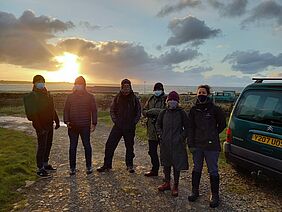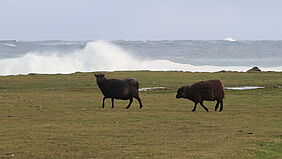On Thursday 21st of October, six of the energy pathfinder project team travelled to North Ronaldsay island to visit the Lighthouse keeper’s cottage, which is one of the Scottish demonstrator buildings. The plane could only accommodate 8 passengers so a representative from each partner attended the trip. North Ronaldsay is Orkney’s most northerly island and is further North than the southern tip of Norway. This island is just three miles long and two miles wide and we were hit by the exposed weather conditions as well as the rugged beauty on arrival at sunrise.
On arrival we met with Sara Macias-Rodriguez, the local Community Development manager. We then visited the bird observatory and met with Heather Woodbridge, the local Councillor who is also on the Board of the North Ronaldsay Trust, who owns the Lighthouse Keeper Cottage.
Following this we went to the Lighthouse keeper’s Cottages which is one of Historic Environment’s Scotland’s (HES) demonstrator buildings for the energy pathfinder project. The remote location of the building presents multiple challenges from an energy retrofit perspective, including high exposure, limited vehicular access to the island, and curtailed renewable generation due to export capacity limitations. Amongst these challenges there are also opportunities, however, such as the high average wind flow which already powers four wind turbines on site. The demonstrator buildings themselves are two 19th century structures constructed by the Northern Lighthouse Board, the south-east block is the earlier of the two (1850s) and is of solid brick construction, while the north-west block was constructed later (late Victorian to early 20th century) and is of poured concrete construction.
Kenneth Easson, from HES commented that “The Keeper’s Cottages at the North Ronaldsay Lighthouse present an interesting challenge from a technical perspective considering the intersection of their heritage significance, extreme local climate, atypical building fabric, and unusual setup of the existing energy systems.” The stout walls and low form factor of the two blocks is reflective of the local environment they were designed for, with large windows designed to admit large amounts of sunlight during the day but with built-in shutters and heavy curtains for use at night, reflecting a balance struck by the original designers between energy efficiency and a healthy indoor environment.
Kenneth also highlighted that “the cottages represent an important asset to the local community, providing income to the development trust via the two AirBnB units and currently hosting a woollen mill processing wool from the island’s unique flock of local sheep.” “As a case study, this represents a great opportunity for us to assist the North Ronaldsay Trust in determining an optimal strategy for improvement of the buildings’ energy performance and also to study and learn about the challenges of retrofit in such a remote and challenging setting” remarked Kenneth. Jose Ospina, project manager for the energy pathfinder project added that “the Light house Keepers’ Cottage on the Isle of Ronaldsay was a great example of Historic Environment Scotland's agile approaches to retrofitting on remote Scottish Islands. The problems illustrated by this Pilot are typical to many historic buildings in remote islands and regions of the Northern Periphery.” Following this we got the opportunity to visit the island’s woollen mill which is housed in the former engine room on the same site as the lighthouse. Mark Holbrook from the Trust showed us the process for how the fleece from the seaweed-eating sheep is turned into yarn.
Lastly, we visited some traditional stone buildings that had fallen into disrepair but had some unique features such as the large flagstone on the roof. It was then time to get the plane back to Kirkwall. The group all commented on how beneficial the trip to the island was as well as the warm welcome received from all those, we met living on the island. Jose Ospina, Project Manager for the Energy Pathfinder project added that “this study visit was a much-needed reminder of the challenges of retrofitting historic buildings in the NPA regions, and the commitment and imagination of vibrant agencies and communities that are tackling this challenge.”




